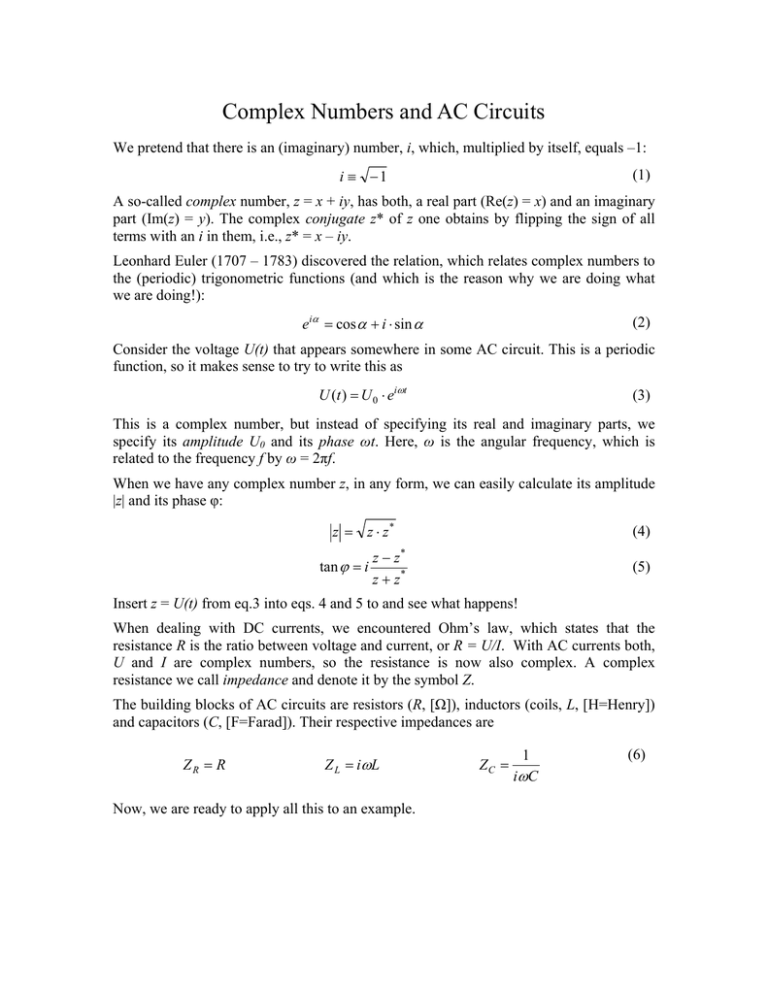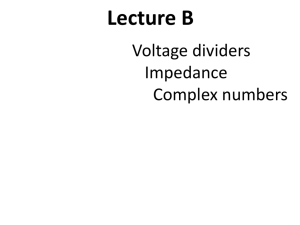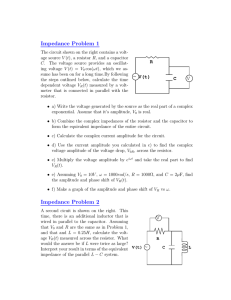Complex Numbers and AC Circuits
advertisement

Complex Numbers and AC Circuits We pretend that there is an (imaginary) number, i, which, multiplied by itself, equals –1: (1) i ≡ −1 A so-called complex number, z = x + iy, has both, a real part (Re(z) = x) and an imaginary part (Im(z) = y). The complex conjugate z* of z one obtains by flipping the sign of all terms with an i in them, i.e., z* = x – iy. Leonhard Euler (1707 – 1783) discovered the relation, which relates complex numbers to the (periodic) trigonometric functions (and which is the reason why we are doing what we are doing!): eiα = cos α + i ⋅ sin α (2) Consider the voltage U(t) that appears somewhere in some AC circuit. This is a periodic function, so it makes sense to try to write this as U (t ) = U 0 ⋅ eiωt (3) This is a complex number, but instead of specifying its real and imaginary parts, we specify its amplitude U0 and its phase ωt. Here, ω is the angular frequency, which is related to the frequency f by ω = 2πf. When we have any complex number z, in any form, we can easily calculate its amplitude |z| and its phase φ: z = z ⋅ z* tan ϕ = i (4) z − z* z + z* (5) Insert z = U(t) from eq.3 into eqs. 4 and 5 to and see what happens! When dealing with DC currents, we encountered Ohm’s law, which states that the resistance R is the ratio between voltage and current, or R = U/I. With AC currents both, U and I are complex numbers, so the resistance is now also complex. A complex resistance we call impedance and denote it by the symbol Z. The building blocks of AC circuits are resistors (R, [Ω]), inductors (coils, L, [H=Henry]) and capacitors (C, [F=Farad]). Their respective impedances are ZR = R Z L = iωL Now, we are ready to apply all this to an example. ZC = 1 iω C (6) In “Electrical Measurements II” we studied a voltage divider that contained a coil and a resistor (see figure). The output voltage U2 can be calculated exactly as we did it for the DC case, but instead of resistor values we now use impedances (in this particular case, the only new thing is that ZL is imaginary) U 2 (t ) = U1 (t ) ⋅ ZR ZR + ZL (7) The alternating input voltage we simply set to U1 (t ) = U10 eiωt (8) Inserting the appropriate expressions for ZR and ZL (eq. 6), and using eq. 4, we find the amplitude of the output voltage as a function of frequency U 20 (ω ) = U 2 ⋅ U 2* = U1 ⋅ U1* R R • = R + iωL R − iωL U10 1+ ω2 L2 R2 (9) If ω = 0, the input and output amplitudes are the same, but for large ω, the output goes to zero. For this reason, this circuit is called a “Low-pass filter”. The phase shift φ between input and output can be calculated with eq. 5: ωL U 2 − U 2* tan ϕ = i = .... = * R U2 + U2 (10) But when we compare these theoretical expressions with our measurement, we see that there is a “little” problem: theory and data look totally different! The reason for this is that our coil not only has a certain inductance L, but also a small capacitance C in parallel. Thus, the correct Zcoil is given by Z coil 1 iω L Z L ZC iωC = ... = iωL = = Z L + Z C iω L + 1 1 − ω 2 LC iωC (11) The remarkable thing is that there is a value for ω for which Zcoil becomes infinite and the output amplitude goes to zero. Replacing ZL in eq. 7 by Zcoil, you can get the correct expressions for U20 and tanφ: try it!



